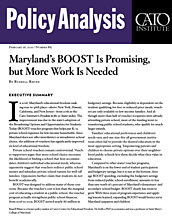Notes
1 Maine and Vermont have voucher programs dating back to the 1800s that only apply to children living in districts that do not operate any public schools.
2 An additional 300,000 children exercise private school choice using tax-credit scholarships and education savings accounts. See The ABCs of School Choice: The Comprehensive Guide to Every Private School Choice Program in America, 2019 Edition (Indianapolis: EdChoice, 2019).
3 The 123s of School Choice: What the Research Says about Private School Choice Programs in America, 2019 Edition (Indianapolis: EdChoice, 2019).
4 Dennis Epple, Richard E. Romano, and Miguel Urquiola, “School Vouchers: A Survey of the Economics Literature,” Journal of Economic Literature 55, no. 2 (2017): 441–492.
5 Andrew Wimer, “19th-Century Discrimination Is Still the Law Across the United States,” Forbes, June 17, 2019.
6 William Ruger and Jason Sorens, Freedom in the 50 States: An Index of Personal and Economic Freedom, 5th ed. (Washington: Cato Institute, 2018), https://www.freedominthe50states.org/.
7 Maryland Alliance of Public Charter Schools, https://www.marylandcharterschools.org/; and “Public School Enrollment, Historical 2018 and Projections 2019 to 2028,” Department of Planning, Maryland State Data Center, https://planning.maryland.gov/MSDC/Pages/school_enrollment/schoolenrollmentprojection.aspx.
8 “Charter Schools,” Maryland Alliance of Public Charter Schools, https://www.marylandcharterschools.org/charter.
9 Children’s Scholarship Fund Baltimore, http://csfbaltimore.org.
10 Child Nutrition Programs: Income Eligibility Guidelines, 84 Fed. Reg. 10,295 (March 2019).
11 Karen B. Salmon, Joint Chairman’s Report—BOOST December 2018 (Baltimore: Maryland State Department of Education, January 15, 2019), p. 1.
12 Salmon, BOOST December 2018; Karen B. Salmon, Joint Chairman’s Report—BOOST December 2017 (Baltimore: Maryland State Department of Education, December 31, 2017); Karen B. Salmon, Joint Chairman’s Report—BOOST December 2016 (Baltimore: Maryland State Department of Education, December 15, 2016); and H.B. 100, 2019 Reg. Sess. (Md. 2019), p. 154, http://mgaleg.maryland.gov/2019RS/bills/hb/hb0100E.pdf.
13 Salmon, BOOST December 2018, p. 3.
14 “Vouchers,” Maryland State Education Association, https://www.marylandeducators.org/hot-issues/vouchers.
15 Benjamin Scafidi, The Fiscal Effects of School Choice Programs on Public School Districts (Indianapolis: EdChoice, March 2012).
16 Salmon, BOOST December 2018; Salmon, BOOST December 2017; Salmon, BOOST December 2016; and “Selected Financial Data Maryland Public Schools SY2016–2017 and SY2017–2018, Part 3 – Analysis of Costs,” Maryland State Department of Education.
17 Scafidi, Fiscal Effects of School Choice Programs, p. 13.
18 Per-pupil costs for school year 2018–2019 were not available at the time of this writing, so school year 2017–2018 costs are used to estimate annual savings from students transferring out of public schools for both years.
19 Martin F. Lueken, Fiscal Effects of School Vouchers: Examining the Savings and Costs of America’s Private School Voucher Programs (Indianapolis: EdChoice, September 2018), p. 2.
20 Jeff Spalding, The School Voucher Audit: Do Publicly Funded Private School Choice Programs Save Money? (Indianapolis: EdChoice, September 2014), pp. 1–2.
21 “Vouchers,” Maryland State Education Association.
22 Salmon, BOOST December 2018, p. 37.
23 Gloria G. Guzman, “Household Income: 2017, American Community Survey Briefs,” U.S. Census Bureau report no. ACSBR/17–01, September 2018; and Salmon, BOOST December 2018, p. 37.
24 “Vouchers,” Maryland State Education Association.
25 National Center for Learning Disabilities, “Vouchers, Education Savings Accounts, and Tax Incentive Programs: Implications and Considerations for Students with Disabilities,” white paper, September 2017.
26 Salmon, BOOST December 2018, p. 36, 41.
27 “Vouchers,” Maryland State Education Association.
28 123s of School Choice; and Epple, Romano, and Urquiola, “School Vouchers,” pp. 441–492.
29 “Mobile Digest of Education Statistics, 2017,” National Center for Education Statistics, https://nces.ed.gov/programs/digest/mobile/Enrollment_ES.aspx.
30 Lueken, Fiscal Effects of School Vouchers.
31 “National Population by Characteristics: 2010–2019,” U.S. Census Bureau, last revised December 30, 2019; Lueken, Fiscal Effects of School Vouchers; Salmon, BOOST December 2018, p. 3; and author’s calculations.
32 School year 2018–2019 budgetary savings were nearly $2.3 million for 3,136 vouchers (see Table 1). Assuming a similar ratio of public school transfers to nontransfers, a five-fold increase in vouchers would result in a five-fold increase in savings.



